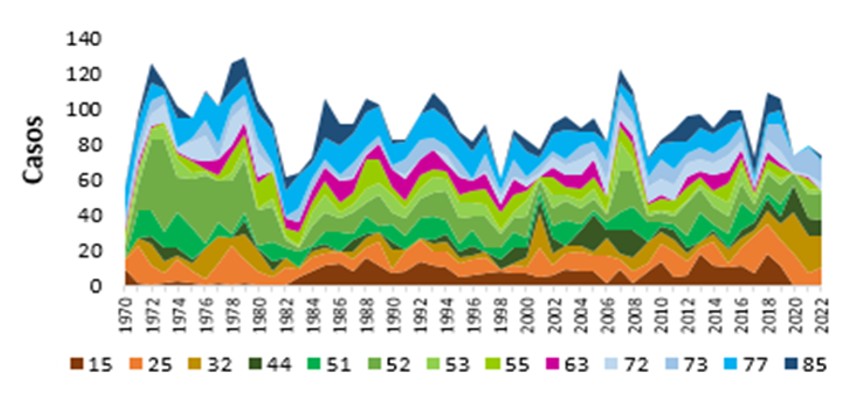Synoptic climatology in Cuba. Part 4: The behavior of concatenated types of situations (1970-2022)
Main Article Content
Abstract
The classification of the Types of Synoptic Situations that affected the western and eastern halves of Cuba in the period 1970-2022 was the basis for developing the climatology of the concatenated types of synoptic situations that influence the Cuban archipelago and adjacent marine areas, by combining the codes of both regions that meet the classification principles. The objective of the work is to describe the main climatic characteristics of the atmospheric processes that contain the combination of influential synoptic situations, their multiannual variability, annual march and anomalies. In addition, the trends of several concatenated types were calculated, and maps were objectively prepared showing the main changes observed in regional isobaric patterns, representative of the concatenated types with a significant trend, providing new knowledge about the displacements that are occurring in the average position of the low pressure centers over the Caribbean Sea and Cuba during the peak of the hurricane season. as well as the genesis of the observed changes in the behavior of frontal systems, the increase in weak atmospheric pressure gradients, and the decrease in the length of the winter period in Cuba. Finally, three intervals or periods of years are established, characterized by the predominance of distinct groups of concatenated types, associated with the mechanisms of the general atmospheric circulation that influence North America.
Downloads
Article Details

This work is licensed under a Creative Commons Attribution-NonCommercial 4.0 International License.
Those authors who have publications with this journal accept the following terms of the License Attribution-NonCommercial 4.0 International (CC BY-NC 4.0):
You are free to:
- Share — copy and redistribute the material in any medium or format
- Adapt — remix, transform, and build upon the material
The licensor cannot revoke these freedoms as long as you follow the license terms.
Under the following terms:
- Attribution — You must give appropriate credit, provide a link to the license, and indicate if changes were made. You may do so in any reasonable manner, but not in any way that suggests the licensor endorses you or your use.
- NonCommercial — You may not use the material for commercial purposes.
- No additional restrictions — You may not apply legal terms or technological measures that legally restrict others from doing anything the license permits.
The journal is not responsible for the opinions and concepts expressed in the works, they are the sole responsibility of the authors. The Editor, with the assistance of the Editorial Committee, reserves the right to suggest or request advisable or necessary modifications. They are accepted to publish original scientific papers, research results of interest that have not been published or sent to another journal for the same purpose.
The mention of trademarks of equipment, instruments or specific materials is for identification purposes, and there is no promotional commitment in relation to them, neither by the authors nor by the publisher.
References
Lecha, L., Soler, E., Sánchez, L. y Verdecia, Y. (2024a). La Climatología Sinóptica en Cuba. Parte 2: El Catálogo de los tipos de situaciones. Rev. Cub. Meteorología, 30(1), enero-marzo, 1-19, ISSN: 2664-0880.
Lecha, L., Soler, E., Sánchez, L., Verdecia, Y. y Roura, P. (2024b). La Climatología Sinóptica en Cuba. Parte 3: Características climáticas de los grupos, tipos y subtipos de situaciones 1970-2022. Rev. Cub. Meteorología, 30(2), abril-junio, 1-31, ISSN: 2664-0880.
Pérez, R. (2006). Cronología de los Huracanes de Cuba. Probabilidad de afectación por huracanes en cada provincia de Cuba. Informe abreviado. Instituto de Meteorología, AMA – CITMA, la Habana, Cuba. 8 p. (inédito).
Rasilla, D.F. y García, J.C. (2007). La Climatología Sinóptica en España. Universidad de Cantabria, España, 207-209 pp.
Roura, P., Arenas, J. C., Sistachs, V. y Díaz, D. (2020). TrendSoft: Software para el análisis de tendencia y puntos de cambio de variables climatológicas. Rev. Cub. Meteorología, 26(3), julio-septiembre, 1-16, ISSN: 2664-0880.
Soler, E., Sánchez, L.M., Lecha, L. y Verdecia, Y. (2020). Los mecanismos elementales de circulación en América del Norte y su relación con las situaciones sinópticas que influyen sobre la mitad occidental de Cuba. Rev. Cub. Meteorología, 26(sp), 1-18, ISSN: 2664-0880.
Soler, E., Lecha, L. y Roura, P. (2025). Comportamiento de los procesos regionales de la circulación atmosférica que influyen sobre América del Norte desde finales del siglo XIX. Rev. Cub. Meteorología, 31(2), abril-junio: 1-12. ISSN: 2664-0880.

